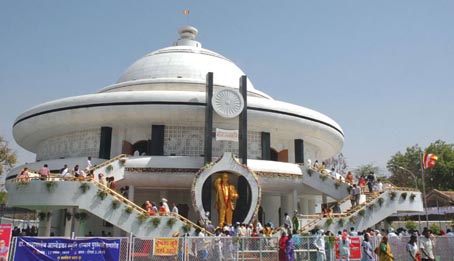
Nagpur
After Indian independence, Nagpur became the capital of Madhya Bharat state. In 1960, the Marathi majority Vidarbha region was merged with the new state of Maharashtra and Nagpur was designated the second capital of Maharashtra state, alternating with Bombay as the seat of the Maharashtra state legislature. Nagpur is one of the major industrial cities of Maharashtra. This district is famous for its orange productions. Many big and leading companies open their base in this city.
Connectivity :
By Road: Mumbai Kolkata NH-6 and Kanyakumari Varanasi NH-7 pass through the city. This city is well connected by road with major cities and villages in and out the state of Maharashtra.
By Train: Electrified broad gauge railway track connects Nagpur to all four major cities and villages of India with Nagpur. Nagpur railway station is an important rail junction on the Central and Southeastern lines.
By Flight: Nagpur is connected with domestic flights with the cities of Mumbai, Calcutta, Delhi Hyderabad, Pune, Bhubaneswar and Raipur. Nagpur’s Sonegaon airport is nearly 8 km south of the city.
Marbat: Marbat is celebrated only in the Nagpur region, especially in the Nagpur city. People prepare statues of evil forces and take out procession in this festival. These statues are burnt at the end, and assumed that all evil forces are burnt. It is believed that the city would be free from all types of evils after it.
Ramjanam: This festival is organized on the birthday of Ramchandra. Ramjanam is celebrated with great enthusiasm and brotherhood in Nagpur. A rath yatra is taken out from the Ram Mandir to major parts of the city. Rath yatra is the procession of God Shri Ramchandraji on chariot. The rath yatra wraps up at the same location where it started. To welcome Ram Chandraji, nearly 2,00,000 people gathers on both sides of the streets. Procession starts with the youngsters on skating wearing traditional dresses. Tribal dances are also performed in front of the chariot. Wearing masks of different Gods, like Ganesh and Hanuman, young boys and girls march ahead of chariot.
The Seminary Hill: It is situated about 6 km from the city and got the name after the St. Charles Seminary which was established during the British Rule. This is a Roman Catholic theological college where priests are prepared. Near seminary a Church and a cemetery are also situated. This hillock offers spectacular views of the surroundings and dense forests
Markanda: The small town of Markanda is named after Markandeya, a popular sage and located on the left bank of Vainganga River. The town has many temples and is quite popular for the ‘Shiva Linga’ that was once worshipped by Markandeya.
Balaji Temple: It is situated at lower Seminary Hill opposite to the Zonal Anthropological Museum. It is dedicated to the Lord Kartikeya or Lord Balaji. The calm natural beauty of the place adds to the serenity of the temple area.
Sitabuldi Fort: It is located on the top of hill and was built by a British officer in 1857. At present, the fort is home to the office of the territorial army and is open for public visit during national holidays only. Inside the fort is a memorial in dedication to all the soldiers who have died in the war between the Marathas and the British.
Dragaon Palace: It is also called as the ‘Lotus Temple of Nagpur,. The temple was built by Mother Noriko Ogawa Society, Japan and inaugurated in 1999. The idol of Buddha in the temple is considered to be carved off a single sandalwood block. The lush gardens and the serene atmosphere elevate your spirits.
Ramtek: Legends believe that it was at the historic Rama’s temple situated in Ramtek, where Lord Rama sojourned during his exile. The Temple is acclaimed not only for its mythological and spiritual value, but also for its architectural significance.



















